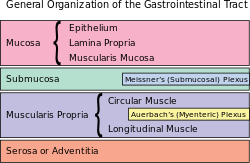
Back جهاز عصبي معوي Arabic অন্ত্রীয় স্নায়ুতন্ত্র Bengali/Bangla Sistema nerviós entèric Catalan Enterická nervová soustava Czech Enteriske nervesystem Danish Enterisches Nervensystem German އެންޓީރިކް ނާރވަސް ސިސްޓަމް DV Sistema nervioso entérico Spanish Enteerne närvisüsteem Estonian Nerbio-sistema enteriko Basque
| Enteric nervous system | |
|---|---|
 The enteric nervous system is embedded in the lining of the gastrointestinal system. | |
| Identifiers | |
| Acronym(s) | ENS |
| MeSH | D017615 |
| FMA | 66070 |
| Anatomical terminology | |
The enteric nervous system (ENS) or intrinsic nervous system is one of the three main divisions of the autonomic nervous system (ANS), the other being the sympathetic (SNS) and parasympathetic nervous system (PSNS), and consists of a mesh-like system of neurons that governs the function of the gastrointestinal tract.[1] It is capable of acting independently of the SNS and PSNS, although it may be influenced by them. The ENS is nicknamed the "second brain".[2][3] It is derived from neural crest cells.[4][5]
The enteric nervous system is capable of operating independently of the brain and spinal cord,[6] but is thought to rely on innervation from the vagus nerve and prevertebral ganglia in healthy subjects. However, studies have shown that the system is operable with a severed vagus nerve.[7] The neurons of the enteric nervous system control the motor functions of the system, in addition to the secretion of gastrointestinal enzymes. These neurons communicate through many neurotransmitters similar to the CNS, including acetylcholine, dopamine, and serotonin. The large presence of serotonin and dopamine in the intestines are key areas of research for neurogastroenterology.[8][9][10]
- ^ Cite error: The named reference
Furness2008was invoked but never defined (see the help page). - ^ Dorland's (2012). Dorland's Illustrated Medical Dictionary (32nd ed.). Elsevier Saunders. p. 1862. ISBN 978-1-4160-6257-8.
- ^ Pocock G, Richards C (2006). Human Physiology The Basis of Medicine (Third ed.). Oxford University Press. p. 63. ISBN 978-0-19-856878-0.
- ^ Barlow AJ, Wallace AS, Thapar N, Burns AJ (May 2008). "Critical numbers of neural crest cells are required in the pathways from the neural tube to the foregut to ensure complete enteric nervous system formation". Development. 135 (9): 1681–1691. doi:10.1242/dev.017418. PMID 18385256. S2CID 7401456.
- ^ Burns AJ, Thapar N (October 2006). "Advances in ontogeny of the enteric nervous system". Neurogastroenterology and Motility. 18 (10): 876–887. doi:10.1111/j.1365-2982.2006.00806.x. PMID 16961690. S2CID 34066966.
- ^ Cite error: The named reference
Gershonwas invoked but never defined (see the help page). - ^ Li Y, Owyang C (September 2003). "Musings on the wanderer: what's new in our understanding of vago-vagal reflexes? V. Remodeling of vagus and enteric neural circuitry after vagal injury". American Journal of Physiology. Gastrointestinal and Liver Physiology. 285 (3): G461–G469. doi:10.1152/ajpgi.00119.2003. PMID 12909562.
- ^ Pasricha PJ. "Stanford Hospital: Brain in the Gut - Your Health". YouTube.
- ^ Martinucci I, Blandizzi C, de Bortoli N, Bellini M, Antonioli L, Tuccori M, et al. (2015). "Genetics and pharmacogenetics of aminergic transmitter pathways in functional gastrointestinal disorders". Pharmacogenomics. 16 (5): 523–539. doi:10.2217/pgs.15.12. hdl:11577/3166305. PMID 25916523.
- ^ Smitka K, Papezova H, Vondra K, Hill M, Hainer V, Nedvidkova J (2013). "The role of "mixed" orexigenic and anorexigenic signals and autoantibodies reacting with appetite-regulating neuropeptides and peptides of the adipose tissue-gut-brain axis: relevance to food intake and nutritional status in patients with anorexia nervosa and bulimia nervosa". International Journal of Endocrinology. 2013: 483145. doi:10.1155/2013/483145. PMC 3782835. PMID 24106499.
© MMXXIII Rich X Search. We shall prevail. All rights reserved. Rich X Search